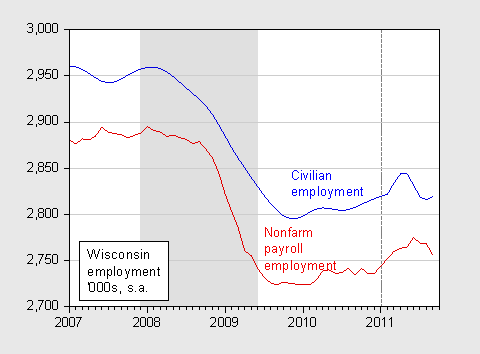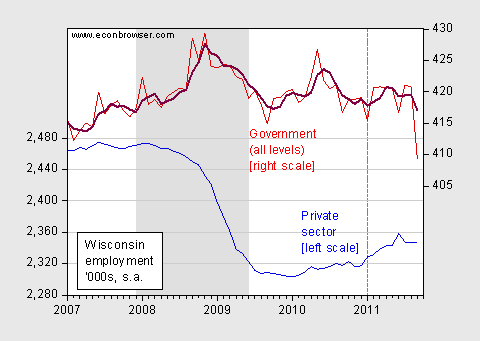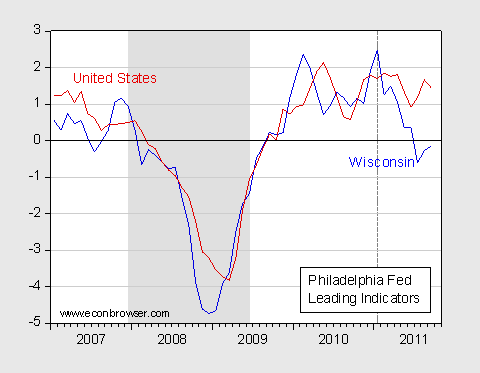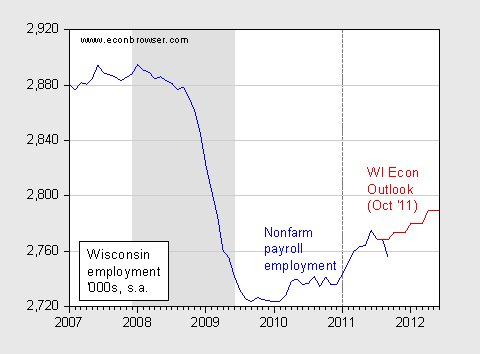Here are some macro indicators for the Wisconsin macroeconomy. In sum, civilian employment is rising (to essentially 2011M01 levels), but nonfarm payroll employment is declining; private sector employment (ex-farm) is flat, while government employment is declining; and leading indicators are pointing to a downturn.

Figure 1: Wisconsin civilian employment (blue), and nonfarm payroll employment (red), seasonally adjusted, in thousands. NBER recession dates shaded gray. Dashed line at 2011M01. Source: BLS, and NBER.
Civilian employment is essentially unchanged since 2011M01. nonfarm payroll employment is up by 11,800.

Figure 2: Wisconsin private sector, calculated as total minus government (blue, left axis), and government employment (red, right axis) and three month moving average (purple, right axis), seasonally adjusted, in thousands. NBER recession dates shaded gray. Dashed line at 2011M01. Source: BLS, NBER and author’s calculations.
Private sector employment has risen 18,000, as government employment has declined.

Figure 3: Leading indices, for Wisconsin (blue) and for US (red). Source: Philadelphia Fed.
The leading indices are described thus:
The leading index for each state predicts the six-month growth rate of the state’s coincident index. In addition to the coincident index, the models include other variables that lead the economy: state-level housing permits (1 to 4 units), state initial unemployment insurance claims, delivery times from the Institute for Supply Management (ISM) manufacturing survey, and the interest rate spread between the 10-year Treasury bond and the 3-month Treasury bill.
A time-series model (vector autoregression) is used to construct the leading index. Current and prior values of the forecast variables are used to determine the future values of the index.
In other words, prospects for Wisconsin are somewhat less bright than for the US overall.
It seems that we don’t necessarily need to wait six months to see the outcome. Figure 4 shows actual nonfarm payroll employment, and the forecast cited by the Fall Wisconsin Economic Outlook, released October 21st.

Figure 4: Wisconsin nonfarm payroll employment (blue), and forecasts from Fall 2011 Wisconsin Economic Outlook (red), seasonally adjusted, in thousands. NBER recession dates shaded gray. Dashed line at 2011M01. Source: BLS, Wisconsin Economic Outlook Appendix 1, and NBER.
As noted in AP via Business Week (October 24th):
The secretary of the agency in Gov. Scott Walker’s administration charged with connecting job seekers with employers resigned Monday, marking the second time in 10 months that the head of the department abruptly quit.
…Walker’s main campaign pledge was that as governor there would be 250,000 private sector jobs added under his watch by 2015.
But in Walker’s first nine months in office, just 29,300 jobs have been added, which is not on pace for him to meet his campaign pledge. The unemployment rate in September was 7.8 percent. On Friday, Walker’s own Revenue Department released a more pessimistic economic forecast that predicted that by the end of 2014 only 136,000 jobs will have been added in Wisconsin.
In my view, the lackluster performance along several dimensions of economic activity is not particularly surprising. See [1], [2].
Well, personally I thought you’d post on the re-instatement of collective bargaining in Ohio.
Some OTs:
I had an interesting week here in Houston.
I attended the Teledyne conference on Wednesday. I was favorably impressed. Teledyne has one of the last (partially government funded) labs left. The lab specializes in materials testing, useful for all of military, space–and oil and gas–applications. I think Mike Read, their CEO, has a good, coherent strategy. For those interested in these things, the company is well worth a look. A true company for geeks. President Obama could do worse than visiting their research labs in Daytona Beach. These guys actually know how to make money!
This afternoon I visited with Groppe and Littell. The firm is famous for its hardscrabble, contrarian views of oil and gas markets. They educated me on the potential for shale gas. Their take: Horizontal drilling essentially permits the faster draining of reservoirs. At current paces, the expect the US to blow through most of the shales by 2020. PFC Energy, a DC firm, is more optimistic. Still, if you factor in shales and conventional gas using the G&L view, then decline rates from conventional catch up pretty quickly with shales. Made we want to run out and buy 2014 natural gas futures.
Also on hydrofracking: Halliburton is looking into making fracking additives entirely from food additives. That’s a neat approach, I think. If they believe G&L, they should plan to get it in the market before 2020.
Steven,
Chesapeake’s DFW Airport Lease is an interesting case history in the Barnett Shale. They predicted total cumulative production of about 1,000 BCF from the 18,000 acre lease, with per well cumulative production of 3 to 4 BCF, and they described the DFW Airport as one of the best areas in the entire play. They predicted that late 2011 daily production would be about 250 MMCFPD.
It looks like late 2011 daily production may be down to about 25 MMCPD, with average cumulative production per well, if they are lucky, of about one BCF. And it appears that the decline rate in recent months was accelerating.
You read my mind, Menzie. I was also assembling a look at Wisconsin jobs from 2009-2011, and for the Walker era of 2011.
If you support Scott Walker, ya might want to rethink that support after looking at this. There’s a reason he’s going to be able to have a full-time gig on Fox News come this Summer.
I’ve got $1000 that says that Walker beats a recall. Any takers?
Buzzcut_ Basement dwellers like you don’t have $1000 to their names, so why would I bet that?
2nd- Given that I actually live in Wisconsin and have seen the state fall to worst-in-nation in job performance under Walker, and because Wis will have a 500 million budget deficit open up for this fiscal year (let alone the deficit for the next one), Walker only has Faux watchers like you left supporting him. Shoot, I could be able to beat him in an election by May.
Sorry, but at a certain point, reality and results do matter.